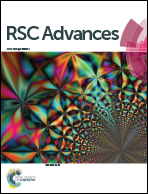Enhanced ionic conductivity in halloysite nanotube-poly(vinylidene fluoride) electrolytes for solid-state lithium-ion batteries†
Abstract
Solid composite electrolytes have gained increased attention, thanks to the improved safety, the prolonged service life, and the effective suppression on the lithium dendrites. However, a low ionic conductivity (<10−5 S cm−1) of solid composite electrolytes at room temperature needs to be greatly enhanced. In this work, we employ natural halloysite nanotubes (HNTs) and poly(vinylidene fluoride) (PVDF) to fabricate composite polymer electrolytes (CPEs). CPE-5 (HNTs 5 wt%) shows an ionic conductivity of ∼3.5 × 10−4 S cm−1, which is ∼10 times higher than the CPE-0 (without the addition of HNTs) at 30 °C. The greatly increased ionic conductivity is attributed to the negatively-charged outer surface and a high specific surface area of HNTs, which facilitates the migration of Li+ in PVDF. To make a further illustration, a solid-state lithium-ion battery with CPE-5 electrolyte, LiMn2O4 cathode and Li metal anode was fabricated. An initial discharge capacity of ∼71.9 mA h g−1 at 30 °C in 1C is obtained, and after 250 cycles, the capacity of 73.5 mA h g−1 is still maintained. This study suggests that a composite polymer electrolyte with high conductivity can be realized by introducing natural HNTs, and can be potentially applied in solid-state lithium-ion batteries.



 Please wait while we load your content...
Please wait while we load your content...